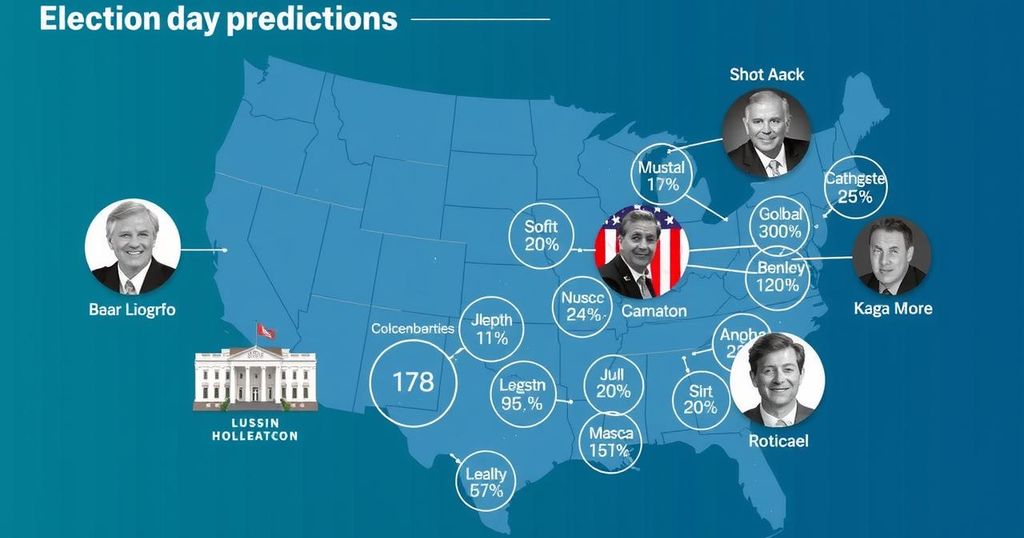World news
2024 PRESIDENTIAL ELECTION, AFRICA, AMERICA, CONGRESS, CUBA, DONALD TRUMP, ELECTION, FLORIDA, GARY JOHNSON, JAMES HOHMANN, JAMES HOHMANN EUGENE ROBINSON, KAREN, MADISON SQUARE GARDEN, NORTH AMERICA, OHIO, PRESIDENTIAL CANDIDATES, PRESIDENTIAL ELECTION 2024, SOUTH AFRICA, U.S. ELECTIONS, US ELECTIONS, UTAH, VIRGINIA
Daniel O'Connor
0 Comments
Election Predictions: Insights from Eight Columnists on Kamala Harris vs. Donald Trump
A cohort of eight columnists shares their predictions for the impending election, evaluating the chances of Kamala Harris and Donald Trump while emphasizing the growing polarization and the reduction of competitive swing states. Key issues such as abortion rights and economic concerns are discussed, along with varying predictions regarding specific states such as Nevada and Wisconsin. Overall, uncertainty prevails as the columnists acknowledge the difficulty of accurately forecasting the election outcome.
In anticipation of the upcoming election, eight columnists provide their insights and predictions concerning the probable outcomes for the presidency and Congress. The discourse revolves around key swing states, particularly regarding the contest between Democratic Vice President Kamala Harris and former President Donald Trump. James Hohmann reflects on the uncertainty surrounding election predictions, expressing his notion that Trump appeared to undermine his chances in the final week. Karen Tumulty recalls the 2016 election’s unpredictability, indicating a similar sentiment among commentators presently. The shrinking of the battleground states is discussed, with an emphasis on polarization that narrows the focus to seven key states compared to fifteen in the previous election cycle. Eugene Robinson similarly underscores the heightened difficulty of making accurate predictions about elections, while Karen notes structural challenges Harris faces, including Biden’s low approval ratings and shifting party identification. The columnists also highlight the diminishing impact of third-party candidates in this election, contrasting with the previous cycle, where figures like Evan McMullin and Gary Johnson played significant roles. The conversation shifts to individual state predictions, particularly Nevada, where differing opinions emerge on whether it will lean toward Harris or Trump due to demographic shifts and political machines still in operation. There is acknowledgement of the influence of abortion rights and economic perceptions on voter sentiment as both crucial issues for the electorate. Polls have remained static, indicating a close race, particularly in Pennsylvania and Wisconsin, with party dynamics and candidate popularity factors contributing to voter turnout expectations. The discussion culminates in a reflection on how the election results might evolve and the factors that will influence voter behavior in the final days leading up to the election. Amidst uncertainty and fluctuating public sentiment, the columnists suggest a reserved approach to assigning probabilities to their predictions, summarizing the complexity of the electoral landscape which renders any singular outcome plausible.
The article presents a collective analysis by eight columnists on the forthcoming election, focusing on predictions for the presidential race between Kamala Harris and Donald Trump. The discussion addresses the environment of heightened polarization, the reduction in the number of competitive swing states, and the underlying issues influencing public opinion such as abortion rights and economic conditions. Through various insights, the columnists illuminate how these factors shape their expectations and analyses leading up to Election Day.
In summary, the columnists collectively highlight the unpredictability surrounding the upcoming election, emphasizing factors like polarization, structural challenges, and key issues expected to influence voter sentiment. As they express varying degrees of confidence in their predictions, they acknowledge that the political landscape remains fluid, ultimately suggesting that any outcome is conceivable based on the dynamic nature of voter behavior and external influences in these final days before the election.
Original Source: www.washingtonpost.com




Post Comment